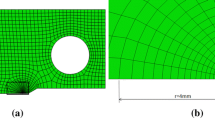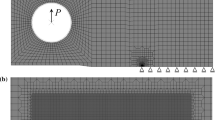Abstract
Using a novel, noncontacting experimental method, the values for creep fracture parameters C(t) and C* have been experimentally quantified from full field, time-dependent surface deformation measurements in the crack-tip region for the first time. Near-tip experimental deformation results were obtained for a stationary crack in alloy IN800 at 650^C and compared to predictions based on both far-field measurement and finite element analyses. Results indicate that (a) for short times, the C(t)- integral is time and path dependent; (b) for long times, the C(t)-integral approached a constant for all paths which is agreement with C* values obtained from far-field experimental data. Comparisons of experimental results with FEM solutions were illustrated by means of radial and angular variations, full-field contour plots, as well as line integration form. Results from these comparisons indicate that (c) the experimental strain data portrays trends similar to those observed in the FEM solutions; (d) experimental, near-tip strain values were different in magnitude from the predicted values for all angles, and (e) the transition time obtained from the tests was about 10 times longer than that calculated from a formula proposed by Riedel and Rice (1980), indicating that primary creep cannot be neglected for this material.
Similar content being viewed by others
References
ABAQUS. Finite Element Code, Hibbitt, Karlsson, and Sorenson, Inc., Providence, RI.
Bassani, J.L. and McClintock, F.A. (1981). Creep relaxation of stress around a crack tip. International Journal of Solids and Structures 17, 479–492.
Deng, X., Sutton, M.A., Yang, L. and Sun, L. (1996). Finite Element Studies of Creep Fracture of a Power–Law Creep Superalloy. Presented at the 33rd Annual Technical Meeting of the Society of Engineering Science, Arizona State University, Tempe, Arizona.
Ehlers, R. and Riedel, H. (1981). A finite element analysis of creep deformation in a specimen containing a macroscopic crack. Advances in Fracture Research. Proceedings, 5th International Conference on Fracture, 2, Pergamon Press, Oxford, 691–698.
Foulds, J.R. (1989). Creep crack growth of alloy 800H in controlled–impurity helium. Nonlinear Fracture Mechanics, Vol. I, ASTM STP 995, American Society for Testing and Materials, Philadelphia, 112–126.
Hoff, N.J. (1954). Approximate analysis of structures in the presence of moderately large creep deformations. Quarterly of Applied Mechanics 12, 49–55.
Hollstein, H. (1986). A fracture mechanics characterization of creep crack growth in incoloy 800H. High Temperature Alloy for Gas Turbines and Other Applications. Proceedings of a Conference held in Liège, Belgium, 1491–1500.
Kumar, V., German, M.D. and Shih, C.F. (1981). An engineering approach to elastic–plastic analysis. EPRI NP–1931, Electric Power Research Institute, Palo Alto, CA.
Liu, J. (1993). Application of digital image correlation technique to determine the coefficient of thermal expansion and high temperature crack tip deformation. Master Thesis, Department of Mechanical Engineering, College of Engineering, University of South Carolina, 29–32.
Liu, J. (1997). Experimental investigation of time–dependent fracture at elevated temperature using digital image correlation technique. Dissertation, Department of Mechanical Engineering, College of Engineering, University of South Carolina, 71–74.
Liu, J., Lyons, J.S., Sutton, M.A. and Reynolds, A. Experimental characterization of crack tip deformation fields in alloy 718 at high temperatures. ASTM Journal of Engineering Materials and Technology (in Review).
Lyons, J.S., Liu, J. and Sutton, M.A. (1996). High–temperature deformation measurements using digital–image correlation. Experimental Mechanics 36(1), 64–70.
Riedel, H. (1981). Creep deformation at crack tips in elastic–viscoplastic solids. Journal of the Mechanics and Physics of Solids 29, 35–49.
Riedel, H. and Detample, V. (1987). Creep crack growth in ductile, creep–resistant steels. International Journal of Fracture 33, 239–262.
Riedel, H. and Rice, J.R. (1980). Tensile cracks in creeping solids. Fracture Mechanics, Twelfth Conference, ASTM STP 700, American Society for Testing and Materials, Philadelphia, 112–130.1.
Shih, C.F. (1983). Tables of Hutchinson–Rice–Rosengren Singular Field Quantities, Brown University Report.
Standard test methods for elevated temperature tension tests of metallic materials. (1996). E 21–92, Annual Book of ASTM Standards, ASTM, Philadelphia, 132–133.
Sutton, M.A., Turner, J.L., Bruck, H.A. and Chae, T.A. (1991). Full–field representation of discretely sampled surface deformation for displacement and strain analysis. Experimental Mechanics 31(2), 168–177.
Sutton, M.A., Deng, X., Liu, J. and Yang, L. (1996). Determination of elastic–plastic stresses and strains from measured surface strain data. Experimental Mechanics 36(2), 99–112.
Yang, L. (1993). A two–dimensional finite element analysis of steady state creep near a stationary crack tip. Master Thesis, Department of Mechanical Engineering, College of Engineering, University of South Carolina.
Yang, L., Sutton, M.A., Deng, X. and Lyons, J.S. (1996a). Finite element modeling of creep fracture initiation in a superalloy. International Journal of Fracture 81(4), 299–329.
Yang, L., Deng, X. and Sutton, M.A. (1996b). Crack–Tip Fields and Singularity–Dominance Zone in a Power–Law Creep Superalloy. Presented at the 1996 ASME Applied Mechanics and Materials Summer Meeting, the Johns Hopkins University; Baltimore, Maryland.
Author information
Authors and Affiliations
Rights and permissions
About this article
Cite this article
Liu, J., Sutton, M., Lyons, J. et al. Experimental investigation of near crack tip creep deformation in alloy 800 at 650^C. International Journal of Fracture 91, 233–268 (1998). https://doi.org/10.1023/A:1007485813696
Issue Date:
DOI: https://doi.org/10.1023/A:1007485813696




